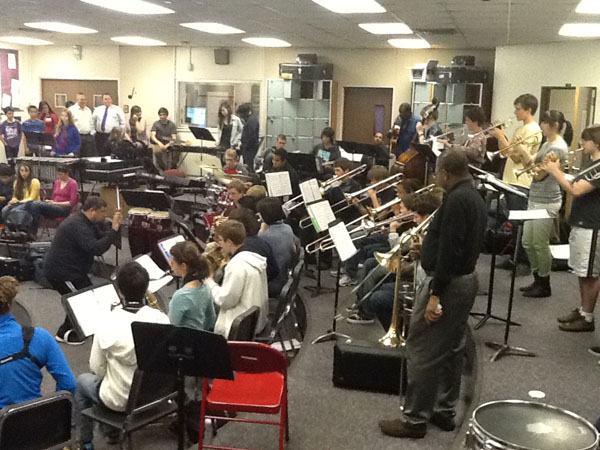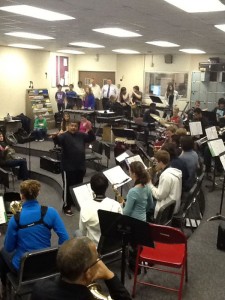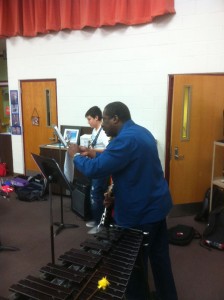
Members of a legendary jazz ensemble that started in the big band era have been mentoring school kids in Anchorage. Members of the Count Basie Orchestra spent time with middle and high schoolers at 18 schools across the city, including with students from West High and Romig Middle School.
“1, 2, 1,2,3,4, 1 …honk! okay, you missed the note…that’s better, okay, let’s get the right note. 1,2,1,2,3,4. Badunk! honk. Okay, you see what’s happening – did you hear that, that’s energy.”
That’s a member of the Count Basie Orchestra working with band students at Romig Middle School.
“Around the world, jazz is respected and known as the only true indigenous American art form,” Dennis Mackrel, director of the Count Basie Orchestra, said.
And for that reason, Mackrel says it’s just as important as reading and writing. The Count Basie Orchestra is credited with helping pioneer Jazz around the world as America’s signature sound.

“This is part of American history,” Mackrel said.
Twelfth grader, Anna Clink, is band’s lone flute player. She thinks the visit is awesome.
“Because we don’t usually get a whole band in here helping us, we’ll have one or two professional people, but it’s really nice to have whole band who can just give us examples about what a good sound is,” Clink said.
Makayla Winchester is in 10th grade. She plays third trombone and is the band manager. She’s also a vocalist.
“Every day, every day i have the blues…,” she said.
Scotty Barnhart, a trumpet soloist with the Basie band gives some feedback.
“First thing that I’d like to say is that it was a great job – energy – it’s just a few little things, the little small things that will make it even better. The first thing that came to mind is when you guys have a fall … just kinds make it a little longer. So don’t be afraid to extend the fall a little bit,” Barnhart said.
“Music is one of those things where even though you can look at it on a piece of paper and you can learn, you can learn the notes, it really is basically a tradition that’s handed down from older musicians to younger musicians,” Mackrel said.
Mackrel says you can tell students how to finger notes on a saxophone or position on a trombone, but what the older musicians are giving the younger players is.

“The inflection that goes behind a note, the emotion that goes behind a note, those things you can’t get from a piece of paper,” Mackrel said.
He says students like the ones at are the ones that will help carry the tradition forward.
At least one student felt that way after the session, 8th grader Erik Falskow.
“I mean there’s like so much stuff that I got out of this today. This is like something that is priceless. I just got a lot of practice ideas, just like what a band should sound like,” Falskow said. “So when we played and then they played the song after us, it was like 10 times better. These guys are like the example and the inspiration.”
Daysha Eaton is a contributor with the Alaska Public Radio Network.
Daysha Eaton holds a B.A. from Evergreen State College, and a M.A. from the University of Southern California. Daysha got her start in radio at Seattle public radio stations, KPLU and KUOW. Before coming to KBBI, she was the News Director at KYUK in Bethel. She has also worked as the Southcentral Reporter for KSKA in Anchorage.
Daysha's work has appeared on NPR's "Morning Edition" and "All Things Considered", PRI's "The World" and "National Native News". She's happy to take assignments, and to get news tips, which are best sent via email.
Daysha became a journalist because she believes in the power of storytelling. Stories connect us and they help us make sense of our world. They shed light on injustice and they comfort us in troubled times. She got into public broadcasting because it seems to fulfill the intention of the 4th Estate and to most effectively apply the freedom of the press granted to us through the Constitution. She feels that public radio has a special way of moving people emotionally through sound, taking them to remote places, introducing them to people they would not otherwise meet and compelling them to think about issues they might ordinarily overlook.




